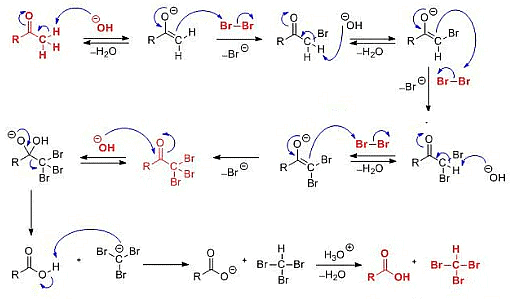Introduction
Haloform reaction mechanism starts with the disproportionation of the halogen with the presence of the hydroxide ion. This gives the halide or the hypohalite. The hydroxide abstracts the proton, producing enolate. The hypohalite also reacts with any present methyl ketones, eventually forming a haloform. The reaction is of the nucleophilic substitution type. An example for the haloform reaction is provided below. In the reaction given above, it can be observed that when the methyl ketone is treated with the bromine halogen in aqueous sodium hydroxide solution – Polyhalogenation occurs, followed by the cleavage of the methyl group. The resulting products of the reaction are the carboxylate and the tribromomethane, which is the required haloform. This reaction was formerly used to industrially produce chloroform, bromoform and iodoform. It is one of the oldest known organic reactions, tracing its roots to 1822 when Georges-Simon Serullas added potassium to a solution of Iodine in ethanol and water resulting in the formation of potassium formate and iodoform.
In the reaction given above, it can be observed that when the methyl ketone is treated with the bromine halogen in aqueous sodium hydroxide solution – Polyhalogenation occurs, followed by the cleavage of the methyl group. The resulting products of the reaction are the carboxylate and the tribromomethane, which is the required haloform. This reaction was formerly used to industrially produce chloroform, bromoform and iodoform. It is one of the oldest known organic reactions, tracing its roots to 1822 when Georges-Simon Serullas added potassium to a solution of Iodine in ethanol and water resulting in the formation of potassium formate and iodoform.
Haloform Reaction Mechanism
- Step 1: The base (hydroxide ion) takes out the alpha hydrogen producing enolate. Then, the reaction between the enolate and the halogen occurs, leading to the formation of the halogenated ketone along with the halogens corresponding anion.
- Step 2: Step 1 is repeated twice to yield a tri-halogenated ketone. The net reaction till the formation of the tri-halogenated ketone.
- Step 3: The hydroxide ion acts as a nucleophile and attacks the electrophilic carbon which is doubly bonded to oxygen. This carbon-oxygen double bond becomes a single bond making the oxygen atom anionic. This makes the reformation of the carbon oxygen double bond favourable and the carbon attached to three halogens is displaced, leaving us with the carboxylic acid. An acid base reaction ensues, the carboxylic acid donates a proton to the tri-halomethyl anion giving the required haloform product.
The overall mechanism is given below: Thus, the 3 step haloform reaction mechanism yields the required haloform precipitate, and the halogenation of a methyl ketone with excess halogen results in the formation of carboxylate ion and the haloform. The substrates used in this reaction include methyl ketones, secondary alcohols which are oxidizable to methyl ketones, ethanol and acetaldehyde. Fluoroform cannot be prepared via the haloform reaction as the hypofluorite ion is highly unstable.
Thus, the 3 step haloform reaction mechanism yields the required haloform precipitate, and the halogenation of a methyl ketone with excess halogen results in the formation of carboxylate ion and the haloform. The substrates used in this reaction include methyl ketones, secondary alcohols which are oxidizable to methyl ketones, ethanol and acetaldehyde. Fluoroform cannot be prepared via the haloform reaction as the hypofluorite ion is highly unstable.













